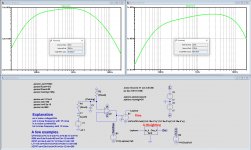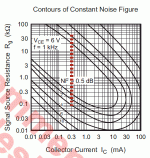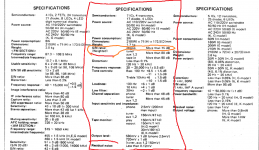Yes, it is. And then put the cartridge on an empty groove and then we can see that we do not need to care so much about the preamp noise. It is only an engineering challenge. In a real world of vinyl records, we can get S/N about 60dB(A).
Why not? On forums like this, people make a big fuss about things that are not likely to be audible under any circumstances, like whether an amplifier distorts 0.01 % or 0.000001 %, while the RIAA amplifier's noise can be audible in between records when the volume knob is turned way to the right.
I used to make valve preamps in two stages with passive RIAA network and inaudible noise at theoretical 2vrms output when not playing anything and very faint hum without any cartridge attached and volume turned way up ...it would be a shame to have noisier preamps in the solid state realm...I wasn't talking about audible noise...but of the "audible" vertues of fet input vs bjt input if there's any...
Last edited:
A friend of mine sent a Teac AS-100 to recap to someone and the guy also replaced the original input transistors with 2sc1815 .I didn't listen to its original shape, but it was dead quiet indeed after replacement .At the time i was into very complex amplifier's topology study as i already had a Kenwood KA-1000 and that Teac which is stuningly simple in its conception hit me like truck with its sound...I was a complete surprise for me.Not as clean or powerfull as the Kenwood but damn good sounding amp for its simplicity.
Last edited:
You might be interested in Hannes Allmaier's High-octane Phono Preamp then, it's an extremely simple circuit with a properly noise-optimized bipolar input stage. High-octane Phono preamp | Linear Audio
I think what is overlooked in the first stage is that this stage is amplifying a reverse RIAA signal.
harmonic distortion from a BJT at low levels is very small meanwhile at higher frequency the harmonics are pushed out of the audio band.
low noise and input impedance matching are key.
harmonic distortion from a BJT at low levels is very small meanwhile at higher frequency the harmonics are pushed out of the audio band.
low noise and input impedance matching are key.
If you've got JFETs, or if you can get JFETs, use them! They are obsolete and they are disappearing fast. Buy em now and use em now, the window is closing.
Later, if you feel like it, you can build a BJT circuit to do the same function, and compare the two. But do the JFET version first, and do it right away. If you sit around in Analysis Paralysis, thinking and worrying rather than building, you'll find it harder and harder to obtain the devices.
RS components do jfet's still. look up dn2530n3-g
i used some for a power amplifier ltp and they worked great.
I have a problem with your graphs, something does not seem right.Please let me demonstrate the effect of MM cartridge to output noise of the MM preamplifier. The preamp is my Phonofet with JFET input. Measurements are made at the preamp output. Input of the preamp is shorted by 50 ohm and in 2nd measurement Ortofon 2m blue cartridge is used. Vrms measurement is calibrated and shown with A weight. Preamp gain is 36dB at 1kHz.
To start with, I don't see the Riaa curve in your images noise when using 50R at the input.
Using 5mV at 5cm/sec@1000Hz, it is easy to calculate that with -94.5dBV(A), the A-weighted input noise of your phono amp is 94nv from 20Hz to 20Khz.
To get this amount of input noise with a 50R resistor, I have to use a Fet Amp with an input noise of 1,31nV/rtHz with a knee point of 100Hz and no current noise at all.
See image below.
When changing the input resistor to 47K with the 700mH and 1k3 from your Orto 2M Blue, the A-Weighted noise increases to 558nV or plus 15.5dB to -79dBV(A) where you specify -87.9dBV(A).
This seems to be impossible.
Hans
Attachments
...Hannes Allmaier's High-octane Phono Preamp...with a properly noise-optimized bipolar input stage. ...
....input transistor I collector is about 300ua, so still high....
....it is higher than the optimal current.
Or you could peep the published 2SC2546 noise curves. NF is 1dB or better from 300r to 35k.
Attachments
RS components do jfet's still. look up dn2530n3-g
i used some for a power amplifier ltp and they worked great.
Except it's not a JFET.
Gerhard
Or you could peep the published 2SC2546 noise curves. NF is 1dB or better from 300r to 35k.
That graph is for resistive sources, while an MM cartridge is mainly inductive. The optimum bias current is practically the same, the graph also shows that the optimum for 12 kohm is around 50 uA, but the noise figure goes up quicker when the source is largely reactive. Nonetheless, 300 uA collector current is small enough to ensure that the base shot noise doesn't dominate.
Just for completeness and out of curiosity, I simulated an Orto 2M Blue with an Utopian completely noise free Fet amp, having even no noise from the feedback resistor.
In that case the equivalent A-weighted input noise solely caused by the Cart is 552nV for a gain of 0dB@1000Hz.
With a reference of 5.5mV at 5cm/sec@1000Hz for this Orto cart, the A-weighted S/N is 20*log(5.5mV/552nV) = 79.97dB(A).
Publications very close or even above this figure are simply based on wrong measurements.
Hans
In that case the equivalent A-weighted input noise solely caused by the Cart is 552nV for a gain of 0dB@1000Hz.
With a reference of 5.5mV at 5cm/sec@1000Hz for this Orto cart, the A-weighted S/N is 20*log(5.5mV/552nV) = 79.97dB(A).
Publications very close or even above this figure are simply based on wrong measurements.
Hans
Thank you Hans ! I'm not as good with numbers and measurements as you or Marcel are, but simple minded people like me rely heavily on real life experiences when assesing an electronic circuit and they have their own way to avoid disasters.
When i started this thread i knew already from many different experiences that good bipolar designs can't be too wrong compared with fet input. Although i have all the needed components to make ultra high end preamps or amps I try hard to do cost down assesements to adjust to the real world because elitism never leads to true value that can be appreciated by many.
There's a guy in my country that 2 years ago made a statement about some 50 euros class d UCD kits compared to a famous accuphase that he owned telling that the new class d kits sound way better than the accuphase.Everybody looked condescendent to him,while many of them didn't even listened to an Accuphase in their life, but he was the owner of both the accuphase and the UCD kits and he could just do all the other snobs do: trying to keep up with a fake opinion in order to overevaluate his accuphase and maybe sell it later for good money.Unfortuantely many DIY guys here are plain snobs that aren't able to stick with the ugly truth of their lives...
For those who can't agree with me i made another topic
https://www.diyaudio.com/forums/the-lounge/357899-audio-guru.html#post6289415
When i started this thread i knew already from many different experiences that good bipolar designs can't be too wrong compared with fet input. Although i have all the needed components to make ultra high end preamps or amps I try hard to do cost down assesements to adjust to the real world because elitism never leads to true value that can be appreciated by many.
There's a guy in my country that 2 years ago made a statement about some 50 euros class d UCD kits compared to a famous accuphase that he owned telling that the new class d kits sound way better than the accuphase.Everybody looked condescendent to him,while many of them didn't even listened to an Accuphase in their life, but he was the owner of both the accuphase and the UCD kits and he could just do all the other snobs do: trying to keep up with a fake opinion in order to overevaluate his accuphase and maybe sell it later for good money.Unfortuantely many DIY guys here are plain snobs that aren't able to stick with the ugly truth of their lives...
For those who can't agree with me i made another topic
https://www.diyaudio.com/forums/the-lounge/357899-audio-guru.html#post6289415
Last edited:
I just took the good old NE5534 bipolar op-amp with 3.4nV/rtHz, where I added some additional noise for a 50R feedback resistor, adding up to 4nV/rtHz.
With all the relevant voltage and current noise as visible in the model below, I get 656nV A-weighted RTI, calculated with a gain of 0dB@1Khz.
S/N is now 20*log(5.5mV/656nV) = 78,5dB(A) for the Orto 2M Blue.
That's only 1.5dB away from the unobtainable 79.97dB(A) limit.
Both OPA1642 and OPA1652 also with the added noise of a 50R feedback resistor, scored 640mV.
The OPA1642 has a somewhat higher voltage noise, but a much lower enk of 13Hz versus 700Hz for the OPA1652.
That brings the A-weighted S/N for both Fet opamps to
20*log(5.5mV/640nV) = 78.6dB(A), exactly a marginal 0.1dB better as the NE5534.
So I don't understand all the fuzz about Fet's being far superior in S/N.
I would personally take the OPA1642, just because the design is much newer.
Hans
With all the relevant voltage and current noise as visible in the model below, I get 656nV A-weighted RTI, calculated with a gain of 0dB@1Khz.
S/N is now 20*log(5.5mV/656nV) = 78,5dB(A) for the Orto 2M Blue.
That's only 1.5dB away from the unobtainable 79.97dB(A) limit.
Both OPA1642 and OPA1652 also with the added noise of a 50R feedback resistor, scored 640mV.
The OPA1642 has a somewhat higher voltage noise, but a much lower enk of 13Hz versus 700Hz for the OPA1652.
That brings the A-weighted S/N for both Fet opamps to
20*log(5.5mV/640nV) = 78.6dB(A), exactly a marginal 0.1dB better as the NE5534.
So I don't understand all the fuzz about Fet's being far superior in S/N.
I would personally take the OPA1642, just because the design is much newer.
Hans
Attachments
Last edited:
Just for completeness and out of curiosity, I simulated an Orto 2M Blue with an Utopian completely noise free Fet amp, having even no noise from the feedback resistor.
In that case the equivalent A-weighted input noise solely caused by the Cart is 552nV for a gain of 0dB@1000Hz.
With a reference of 5.5mV at 5cm/sec@1000Hz for this Orto cart, the A-weighted S/N is 20*log(5.5mV/552nV) = 79.97dB(A).
Publications very close or even above this figure are simply based on wrong measurements.
Hans
I got 75.2 dB ref 5 mV no weighting at 1 kHz (1350 Ohms + 500 mH with 47 k load R) This is with a 110 Ohm source resistor. The noise in any case is dominated by the cart and input load resistor. The amplifier is 1.6 nV/rt Hz and the current noise contribution effectively zero - this to my mind is the advantage of a JFET input. I can get the noise down to 1.1 to 1 nV/rt Hz but this requires some changes to the EQ network.
I agree with your view on the max obtainable figures. But, a good discrete JFET design will get you 3 dB better than a 5534A in a practical amp - which itself is not too shabby especially given that you can get them for about $0.40.
Last edited:
- Status
- Not open for further replies.
- Home
- Source & Line
- Analogue Source
- FET vs BJT input phono preamp



